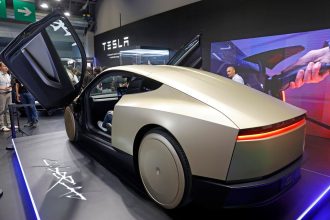With over 30 years in the markets, my focus has always been on uncovering hidden value or actively creating it, and a crucial element of this is leadership. The top executives shape and instill in the company’s culture, cascading it throughout the organization. I’ve often seen that when management fails to lead effectively or exhibits poor leadership, it trickles down to every level of the company, impacting overall performance and value, which ultimately translates into share price underperformance.
Intel
Intel
NVIDIA
Intel’s Building Troubles
The current troubles at Intel provide a fascinating story of a former dominant powerhouse confronting complex issues. The once-proud semiconductor manufacturer has fallen on hard times because of lengthy lags in process technology advancement. These delays have made it more difficult to improve performance per watt, transistor density, and die utilization—factors essential for remaining competitive in the relentless semiconductor industry. This is especially true for its 10nm and 7nm technologies.
The issues with Intel’s production have made the problems worse. Product costs have increased, and gross margins have been squeezed because of the company’s production processes experiencing poorer yields and longer throughput times. Intel has reached its operational efficiency limits because to the increased complexity and costs brought about by the shift to more advanced packaging technologies and disaggregated designs.
Intel faces stiff competition from well-established industry heavyweights such as TSMC and Samsung as it attempts its ambitious pivot into the third-party foundry business. Indeed, in their first reporting of the foundry business as a separate segment, they reported revenue of $4.4 billion, which was down by $462 million compared to the first quarter of 2023. The decrease in revenue was primarily due to lower back-end services and product sample revenues, as well as a decline in equipment sales and traditional packaging services.
Intel finds itself in a complex situation, facing challenges in technical readiness, production capacity, pricing, and customer worries about secrecy because of this strategic move. Large capital expenditures are also associated with the move.
With a whopping $16 billion spent on research and development in 2023 alone, Intel’s financial woes are plain to see. Despite their importance for innovation, these investments run the danger of yielding insufficient profits if the new technology doesn’t live up to market expectations. Intel is especially vulnerable to supplier delays, capacity bottlenecks, and geopolitical conflicts because of its complicated global supply chain and its reliance on ASML for essential EUV photolithography tools.
Government Subsides
The U.S. government recently gave Intel help through the CHIPS
GraniteShares HIPS US High Income ETF
Intel stands to gain financially and strategically, but the company is also vulnerable to certain threats. Intel may be under extra pressure to produce rapid results due to rising public scrutiny and the risk of instability caused by reliance on government support in the event of political or policy changes. Intel may see additional regulatory supervision and bureaucratic impediments because of this massive investment, which could hinder its operational flexibility and strategic execution rather than help it. Another risk to the company with these free handouts.
Former Intel leadership
Several notable leaders have molded Intel. Gordon Moore, Intel’s founder, and CEO from 1975 to 1987, changed the company’s focus from memory products to microprocessors, establishing its chip market dominance. Andy Grove led from 1987 to 1997, boosting the microprocessor industry during the PC boom. From 1997 to 2005, Craig Barrett led the company through the dot-com boom and bust with worldwide production and technological advances. In 2005–2013, Intel CEO Paul Otellini moved into data centers and new digital sectors but missed the mark on mobile. Despite chip production issues, 2013–2018 CEO Brian Krzanich prioritized data centers and the Internet of Things. Bob Swan stabilized the ship throughout competition challenges and production delays from 2019 to 2021. Pat Gelsinger, back at Intel since 2021, is all about revamping its manufacturing edge and ramping up its competitive game in the semiconductor field. Sadly, the train looks like it has left the station, with NIVIDIA and AMD on board.
Gelsinger has an average history at best. Under his leadership, VMware
VMware
Microsoft
Visionaries Driving The Competition
The competition is strong. The semiconductor industry holds Lisa Su, CEO of AMD, in high esteem. Since becoming a leader in 2014, AMD has experienced a significant positive change under her vision, moving the company from near bankruptcy to becoming the global tech leader it is today. She oversaw the phenomenal revival of the company. The company broke sales records and made tremendous strides in graphics and high-performance computers during that time. Su’s emphasis on cutting-edge microprocessors and GPUs has revitalized AMD and transformed it into a formidable competitor to Intel.
NVIDIA CEO Jensen Huang inspires techies. Huang co-founded the company in 1993 and has led the business to GPU technology leadership. Under his vision, NVIDIA became the gaming graphics leader and boldly entered artificial intelligence and deep learning, which would transform technology. Huang’s GPU-driven computing strategy has put NVIDIA at the forefront of autonomous vehicles and virtual reality. His vision and investment in developing technologies have strengthened the company’s industry leadership and garnered praise.
Intel Need A New CEO
To deal with its growing problems and take advantage of new market prospects, Intel desperately needs a change in leadership. The call for new visionary leadership is about more than simply shaking things up at the top; it’s also about reimagining Intel’s place in the future of technology.
Data-centric computing, artificial intelligence, and machine learning are quickly becoming the domains of focus in the technology sector. Someone needs to take the helm at Intel and successfully shift the company’s focus to these potential growth areas. Not only are we not content to merely stay up, but we are determined to lead the way and shape the future of the semiconductor industry.
A revitalization of Intel’s internal culture is also necessary. The right manager could create a more spirited, adaptable, and creative work environment. Intel needs people with the imagination and agility to keep up with the fast-paced IT business, and this kind of cultural revival is essential for that.
Also, strong supply chain management is essential, as Intel’s operational issues during the worldwide chip scarcity demonstrated. Intel might improve its capacity to manage and mitigate risks related to global manufacturing with the help of a new leader who has experience in global operations and can optimize the company’s distribution and production networks.
To sum up, Intel is at a critical juncture. Quick innovation, successful market entry, and improved operating efficiencies are the three pillars upon which the company’s return to semiconductor industry leadership rests. Intel may find the inspiration it needs from a forward-thinking CEO to overcome these obstacles and secure its future. For the larger tech ecosystem that relies on Intel’s breakthroughs, this is as important as it is for Intel itself.
A visionary must take the helm at Intel. Shareholders require it.
Read the full article here
















